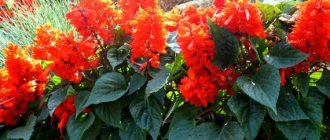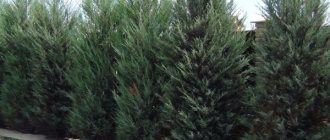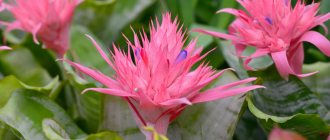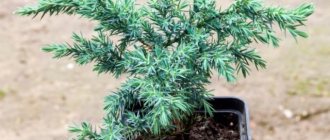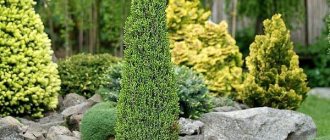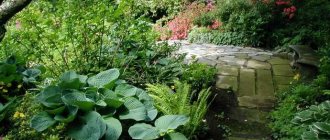Bushes and trees
0
459
Article rating
Kira Stoletova
Skyrocket juniper (Juniperus scopulorum Skyrocket) is a spectacular plant with blue needles and a slender columnar crown. Native to the mountainous areas of Mexico and North America. Translated, the name sounds like “Heavenly Rocket” - and the tree really resembles a spaceship soaring upward.
Rock juniper Skyrocket: secrets of successful cultivation
Description of juniper Skyrocket
Rock juniper Skyrocket (juniperus scopulorum Skyrocket) is a coniferous plant native to Mexico and the USA, belonging to the Cypress family.
Description of the plant:
- height – about 6-8 m;
- The shape of the crown of the bush is columnar;
- crown width – about 100 cm;
- scaly needles have a bluish tint;
- berry-shaped cones have a blue tint;
- the trunk of the bush is flexible and durable, the color of the bark is dark brown;
- trunk diameter is about 20 cm.
Due to its unusual shape, the rock juniper variety was named Skyrocket, which means “soaring up” or “heavenly rocket.”
Winter hardiness of juniper Skyrocket
The winter hardiness of rock juniper Skyrocket is high. This culture tolerates low temperatures down to -25... -30°C. This shrub is intended for cultivation in central Russia and warmer regions.
Ephedra can also be grown in the Volga, North-Western, and Chernozem regions.
In the southern regions, it is better to plant this shrub in shaded areas.
Size and growth rate of Skyrocket juniper
The height of the Skyrocket rock juniper is approximately 6-8 m, and the diameter of the crown is about 1 m or more. The shoots of the plant are quite long and dense, the branches are directed upward.
It is also necessary to familiarize yourself with the peculiarities of the growth rate of the Skyrocket juniper, which is approximately 18-22 cm in height and approximately 4-5 cm in width per year.
In the first three years, the growth rate of Skyrocket rock juniper is very slow
Varieties
This type of juniper has more than 15 varieties, but is considered the most widespread and densely populated in Russia:
- "Blue Arrow"
- "" (Manglow);
- "" (Skyrockett)
"Blue Arrow" It has a high narrow crown, shaped like a column, the name of which translates as “blue arrow”. Shoot growth is about 15 cm per year; this variety of rocky juniper grows in 10 years from 2 to 3 meters in height and 60-70 cm in diameter.
Also, the advantage of “Blue Arrow” over another well-known variety “” is the deeper and more saturated flower of the plants.
Blue Arrow" is used to create landscape compositions in combination with deciduous plants, shrubs and flowers. This is a beautiful hedge that takes up little space and does not require cutting.
Expert Note: An important advantage of the Blue Arrow Arrow juniper is the long-term retention of the lower branches that grow from the very beginning, allowing for endless experimentation in various ornamental applications of this variety.
"Moonglow". It is distinguished by a pyramidal crown shape, has a height of up to 4-6 meters and a width of no more than 1-2 meters.
The growth of shoots does not exceed 10 cm per year, grows vertically and slightly bends to the side. The needles are silvery blue in color and are among the brightest blue varieties.
This variety is drought-resistant and well tolerated in winter frosts. Mainly used for landscaping parks, squares and squares, and will also look harmonious as a potted plant to decorate terraces and balconies.
"Skyrocket". The variety has a narrow and long columnar shape. It grows much faster than other species and reaches a height of more than 3 meters in 10 years. The shoots are located close to the trunk, with an annual growth rate of about 12 cm and blue-green needles.
» has moderate soil and irrigation requirements. Well suited for small garden plots, both single trees and vegetative group compositions.
Watch the video in which an expert explains in detail the features of the rocky blue arrow from juniper:
Page 2
Many people know what Tamarix is, planting and caring for this plant is not difficult, and their photographs confirm that it is very difficult to find more beautiful decorations for landscape design.
Many plants seem to have been created by nature to please the eye.
The elegant branches of Tamarix are compared to emeralds and are covered with flowers of different shades. It all looks charming. The beauty of the bush is especially noteworthy during the flowering period, when it is covered with pearls between the scales of green leaves.
Differences between juniper varieties Blue Arrow and Skyrocket
To distinguish between these varieties, it is necessary to carefully study the following important characteristics of conifers:
- the height of Blue Arrow is much lower - up to 4 m;
- the crown shape of Skyrocket is columnar, while that of its brother is narrower, arrow-shaped;
- the Blue Arrow variety has a deeper blue hue of needles, and the branches fit tightly to the trunk;
- the color of Skyrocket's needles is more grayish-green and only from a distance does a sky-blue tint appear;
- The branches of rock juniper Skyrocket are more spreading than those of Blue Arrow and, if not trimmed, the plant takes on an unkempt appearance.
The Blue Arrow variety has a narrower crown shape and a bluish tint of needles. Warning! Despite the obvious differences between the varieties, young seedlings of these plants are easy to confuse.
Juniper Skyrocket in landscape design
This shrub is often used in the design of local areas, alleys, gardens and parks. The correct conical shape, beautiful shade of needles and ease of care are the main advantages of the plant.
This variety of coniferous shrub is often used to create original living fences.
The correct conical shape and branches reaching upward add sophistication to the landscape.
This conifer is often used in landscape design to create rock gardens, a massive vertical accent in various compositions.
Shrubs look great both individually and in groups.
Rock juniper harmonizes perfectly with other plants, so it is successfully used in creating compositions for gardens of various styles, decorating parks and alleys.
Reproduction methods
There are several options for propagating this variety of shrub:
- cuttings;
- seeds;
- bends.
The easiest way to propagate the crop is from seeds. However, the first shoots will appear no earlier than in a year, so this method is rarely used.
The branching method is quite labor-intensive and ineffective, since the branches of the tree are long and difficult to press to the ground.
The most versatile and effective option for breeding Skyrocket rock juniper is cuttings.
For propagation by cuttings, it is better to use the upper branches of the bush
How to propagate rock juniper?
Reproduction of rock juniper occurs through layering and cuttings. And also through vaccinations. If you decide to propagate the plant through cuttings, then in the spring you need to prepare cuttings. To do this, not completely woody branches with a small piece of wood are cut off. The cuttings are planted in the greenhouse until they are completely rooted. Next, they are planted temporarily in a small bed. The period during which rooting occurs can be from one and a half to six months. It depends on the age and variety. Growing up takes place from 3 to 6 years in a place specially designed for this.
Only those varieties that have creeping forms can be propagated using layering. In this case, the young stem is cleared of needles, bends to the ground and is fixed. The soil where the young shoot will be directed must be cleared of debris and weeds in advance. Rooting of cuttings occurs in the interval from 6 months to 1 year. Next, they need to be separated from their parent. And transplant it into a temporary bed, which should be located in the shade.
To propagate rock juniper using grafting, you will need knowledge. And also the skills of a professional. It will be extremely difficult for an amateur gardener to do this.
Planting and caring for Skyrocket juniper
It is advisable to plant rock juniper in sunny, well-protected places from drafts. This plant takes root well in loose and poor, dry and moderately moist soils. However, when planting in dense soil or loam, it is necessary to create a drainage layer of crushed brick, crushed stone, and pebbles.
Rock juniper is an absolutely unpretentious coniferous shrub to grow. However, before planting, it is necessary to prepare the soil. First of all, you need to remove the weeds and dig up the soil in the area where the shrubs will be planted.
Important! In order for the plant to take root and develop well, the first three years it is necessary to add humus or a nutritious peat mixture to the soil.
Rock juniper is best planted in spring
Plants in containers can be placed on the site at any time of the year, except winter.
Algorithm for planting rock juniper:
- The size of the recess should be approximately 1.5-2 times larger than the root system of the seedling. The depth is at least 80 cm, the width is twice as large as the container in which the rock juniper seedling grew.
The planting pit must be prepared 2-3 weeks in advance.
- It is necessary to lay a drainage layer approximately 20 cm thick at the bottom. In order for the plant to take root better, the soil can be mixed with a special mixture for coniferous trees, as well as with a substrate of sand and peat.
You can prepare a mixture for planting juniper yourself
- The seedling should be removed from the pot very carefully so as not to damage the root system or break the earthen lump.
- The root collar should rise slightly above the soil level.
- The roots should be covered with nutritious soil, compacted and watered abundantly.
The next day, it is worth adding soil so that the roots of the seedling are not exposed when the soil shrinks
The younger the juniper seedling, the greater its survival rate.
Important! Perennials should be planted at a distance of at least 1.5-2 m from each other.
Saplings with bare roots are placed in a container of water before planting, and young bushes in pots are watered abundantly.
Landing Features
You can plant Skyrocket junipers in the spring - at the end of April or at the beginning of May. In the south, gardeners successfully practice autumn planting - in the first half of September.
The main conditions for successful rooting are a warm and stable temperature within 8-10°C.
Selection of seedlings
The choice of planting material should be approached responsibly, since the further growth of the tree and decorativeness will depend on its quality and health.
You can buy this variety of conifer at a gardening nursery at a price of 800-1500 rubles, depending on the height.
When purchasing, you need to conduct a thorough inspection of the above-ground parts and roots:
- the needles of healthy junipers are of a uniform tone, without yellowness, red spots, or drying areas;
- the central conductor and adjacent branches are flexible, without cracks, breaks or signs of disease;
- the underground part (if it is open or with an earthen lump) is brown in color and does not contain mold or acidification.
- The best option would be a plant planted in a container. This way you will probably get a specimen with a fresh root system that will not dry out after replanting.
As practice shows, conifers 2-3 years old with closed roots take root well.
Preparing the site
The plant is a light-loving plant, so it should be planted in a sunny place, but with the possibility of shading during lunch hours. Otherwise, the needles on young plantings will quickly burn and crumble. You can plant it near a fence, under spreading trees or against the walls of a house.
Choose a site that is windless and has deep groundwater flow - up to 2 m. The soil is suitable for loamy or sandy loam.
- In the first case, the composition of the soil is improved with sand and peat - 20 kg per 1 m²;
- In the second, two buckets of clay are added.
The acidity indicator is no less important - it should be neutral (5-6 units). If it exceeds the norm, add 350 g of calcite, slaked lime or dolomite flour for further digging.
Aftercare
Rock juniper Skyrocket is an unpretentious plant. However, caring for this shrub has its own characteristics.
Watering and fertilizing schedule
Juniper does not need frequent watering. In dry weather, the plant should be irrigated 2-3 times per season at the rate of 10 liters per 1 m of growth. In order for the juniper needles to remain fresh and bright, it is necessary to sprinkle the bush.
For better growth and development of the plant, fertilizing should be applied for the first 2-3 years. In the spring, complex mixtures and nitroammophos should be added to the soil, and potash fertilizers should be added in October.
Pruning rock juniper Skyrocket
Rock juniper Skyrocket requires regular pruning. Removal of branches is carried out in early spring. Sanitary pruning involves cutting off dry and damaged shoots, while decorative pruning involves giving the plant crown the desired shape.
Mulching, loosening the soil
In order to better retain moisture, it is necessary to regularly treat the top layer of soil with mulch. Immediately after planting, the tree trunk circle is treated:
- sawdust;
- pine bark;
- peat crumbs;
- dry pine needles.
Layer – 5-7 cm.
Loosening of the soil is carried out after watering in the tree trunk circle to a depth of no more than 6-7 cm.
Preparing for winter
With the onset of the first frosts, the crown of the Skyrocket rock juniper must be tied so that in winter the snow does not damage the branches of the plant.
Young shrubs are insulated with burlap, spruce branches or special covers; adult plants do not need to be covered. To avoid burns, in February the crop is shaded with a net.
Snow can damage or deform shrub branches
Reviews
According to numerous positive reviews, the Skyrocket variety is one of the most popular:
- juniper is not afraid of gas pollution, does not take up much space, so it can be planted in any corner of the garden;
- tolerates severe frosts well, does not require shaping and shelter in adulthood, which greatly facilitates care;
- combines with all plants, which allows you to use it in different compositions;
- propagated by cuttings, which successfully take root in open ground and retain all the qualities of the mother tree.
Pests and diseases
Rock juniper Skyrocket has high resistance to diseases. However, this plant often suffers from fungal infections, such as rust. It manifests itself in the form of spindle-shaped growths of a reddish hue, from which yellow mucus is secreted.
At the first manifestations of a fungal infection, the bush must be treated with copper-containing preparations
If this is not done, the plant will die and it will be impossible to save it.
Important! To prevent infection of Skyrocket rust, it is necessary to plant the crop away from fruit trees.
Insect pests of this plant are:
- scale insect;
- caterpillars;
- hermes;
- mole;
- spider mite
